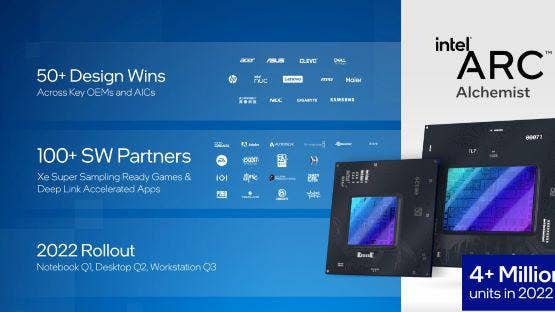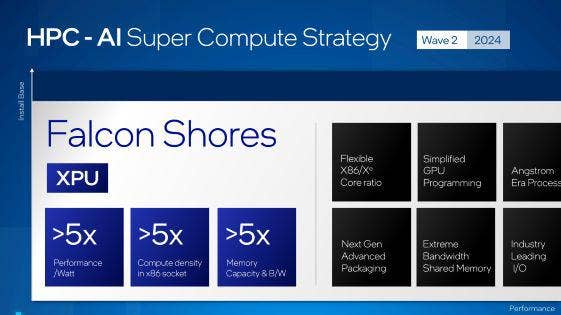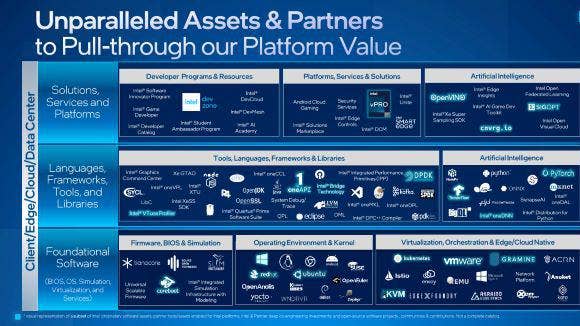6 Big Announcements At Intel Investor Day 2022: GPUs, CPUs And More
Intel CEO Pat Gelsinger and other executives used Intel Investor Day 2022 to make several new disclosures, including a new Xeon server CPU road map that has been bifurcated into two tracks and new CPU-GPU hybrid products for PCs and supercomputers.

New CPU-GPU Hybrids, New Xeon CPU Road Map
Intel used its Intel Investor Day event on Thursday to convince shareholders that CEO Pat Gelsinger’s comeback plan is on track to make the chipmaker the “unquestioned leader” in the semiconductor industry once again, and that included some big announcements.
In his keynote, Gelsinger promised that Intel would double its revenue and quadruple total shareholder value over the next several years.
“The Intel turnaround train is leaving the station, and I hope you all get on board. It’s an ambitious goal, but I am confident Intel’s best days are in front of us,” he said.
[Related: Intel CEO Pat Gelsinger: The Silicon Man With The Software Plan]
Gelsinger and other executives used Intel Investor Day 2022 to make several new disclosures, including a new Xeon server CPU road map that has been bifurcated into two tracks, new CPU-GPU hybrid products for PCs and supercomputers, and a revenue forecast for the company’s new Accelerated Computing Systems and Graphics Group.
What follows are six big announcements the chipmaker made at Intel Investor Day, which also included a new revenue disclosure for Intel’s software business and a new GPU for media supercomputers.

Intel Bifurcates Xeon CPU Road Map With New Efficient Core Track
Intel CEO Pat Gelsinger revealed a new road map for Xeon CPUs through 2024 that will, for the first time, bifurcate server processor development into two tracks.
The two tracks represent the two microarchitecture types Intel is using for its Alder Lake hybrid architecture for client CPUs: the performance core, which will be optimized for performance in mainstream servers and premium cloud infrastructure, and the efficiency core, which will be optimized for efficiency in cloud infrastructure.
The first track is Intel’s road map for Xeon processors with performance cores, which includes the company’s third generation of Xeon, code-named Ice Lake, and Sapphire Rapids, which is due out later this year. Following Sapphire Rapids, Intel will deliver Emerald Rapids in 2023 and Granite Rapids in 2024 on the performance core road map.
The second track represents an all-new road map for Xeon processors that will use efficient cores, and the first CPU in this track, Sierra Forest, will arrive in 2024.
Both Granite Rapids and Sierra Forest will use the Intel 3 node, previously known as the advanced version of Intel’s 7-nanometer manufacturing process.
Gelsinger said Intel decided to bifurcate the Xeon road map into two tracks on the confidence of the progress it is making with the Intel 3 node.
“This dual-track acceleration of Intel 3 gives us a very competitive product line in 2024 with Granite Rapids, Sierra Forest, and this capability allows us to meet the market needs more effectively as well as deliver unquestioned leadership product performance,” Gelsinger said.

Intel To Ship 4 Million Discrete GPUs For PCs In 2022
Intel said it expects to ship more than 4 million discrete GPUs in 2022, which will consist of a mix of graphics products for laptops, desktops and workstations.
This will begin with the first generation of Intel Arc graphics, code-named Alchemist, for laptops in the first quarter of 2022. Intel will then ship graphics cards for desktop PCs in the second quarter and workstations in the third quarter.
The chipmaker said it has 50 design wins with OEM and add-in board partners for Intel Arc Alchemist, which includes Acer, ASUS, Dell, MSI, Samsung, Lenovo and HP. The company also has more than 100 software partners who are integrating their applications and games with Intel’s Xe Super Sampling and Deep Link technologies, which will boost performance for Intel Arc graphics in multiple ways.
Alchemist will be followed by a next-generation Arc GPU code-named Battlemage in the 2023-2024 timeframe, followed by a future generation code-named Celestial in 2024.
Raja Koduri, head of Intel’s Accelerated Compute Systems and Graphics Group, said Celestial will provide performance leadership for GPUs in every segment Intel competes in, from low-power mobile devices to high-performance workstations.

Intel Will Deliver New CPU-GPU Hybrids For PCs, Supercomputers
Intel said it will deliver new CPU-GPU hybrid products that will provide an unprecedented performance boost over the chipmaker’s previous efforts of integrating graphics into CPUs.
On the client side, the company said Meteor Lake, which is due in 2023, and future generations of Intel Core CPUs will incorporate an Intel Arc GPU tile onto the die alongside the CPU, thanks to Intel’s Foveros 3D packaging technology.
Raja Koduri, head of Intel’s Accelerated Compute Systems and Graphics Group, said it will represent a “new class of graphics” and that “you can’t really call it integrated or discrete.”
“This is super exciting, as this allows us to offer discrete graphics-class performance with the efficiency of integrated graphics,” he said.
On the supercomputer side, Intel disclosed a new architecture called Falcon Shores that will combine a CPU and Intel Xe GPU into a single Xeon socket. Falcon Shores is expected to land in 2024 and use an “Angstrom era” process, and Koduri said it will provide a scalable architecture for all high-performance computing workloads, with flexibility in x86-to-Xe core ratios and simplified GPU programming.
Compared to Intel’s current generation of products, Falcon Shores will provide five times greater performance-per-watt, five times greater compute density in an x86 socket and five times greater memory capacity and bandwidth.

Intel Reveals Industry-First GPU For Media Supercomputers
Intel revealed Arctic Sound-M, which it said is the first GPU in the industry to include a hardware-based AV1 encoder for media processing.
Arctic Sound-M is sampling now, and it will start shipping in mid-2022.
The GPU will target four main application areas: video transcoding, cloud gaming, virtual desktop infrastructure and media AI analytics.
For video transcoding, Intel said Arctic Sound-M will be capable of eight simultaneous 8K streams and more than 30 simultaneous 1080p streams.
For virtual desktop infrastructure, the GPU will be able to provide more than 60 virtualized functions, and in cloud gaming, it will have the ability to stream more than 30 game sessions at once.
As for media AI analytics, the GPU will be able to perform 150 trillion operations per second.
Raja Koduri, head of Intel’s Accelerated Compute Systems and Graphics Group, said the AV1 encoder will provide more than a 30 percent improvement in bandwidth at the same, which will provide a “significant” savings in total cost of ownership “while providing a high-quality experience.”

Intel Expects $10B In Revenue For Accelerated Compute, Graphics By 2026
Intel said its Accelerated Compute Systems and Graphics Group is estimated to make $10 billion in revenue by 2026. With Intel expecting the group to drive more than $1 billion in sales this year, the chipmaker makes clear that it expects the business unit to grow fast over the next four years and provide stiff competition against rivals Nvidia and AMD.
This revenue is expected to come from the three segments within the business unit: the Visual Compute Group, which contains Intel’s GPUs for gaming, content creation and metaverse applications; the Super Compute Group, which contains Intel’s processors for high-performance computing, AI and media processing; and the Custom Compute Group, which contains custom silicon for blockchain, supercomputing at the edge, among other things.

Intel Made $100M In Software Revenue In 2021 But Wants More
Intel brought in more than $100 million in software revenue in 2021, and the chipmaker plans to “substantially grow this opportunity,” according to Greg Lavender, Intel’s CTO and head of the Software and Advanced Technology Group.
Lavender was talking about software “at the top of the stack,” consisting of solutions, services and platforms, which he said will “create new market value through software-as-a-service and subscription services.”
Two AI software businesses that Intel owns – Cnvrg.io and SigOpt — combined with Intel’s OpenVINO toolkit are key examples of solutions and services that “drive much larger valued market-making capabilities that enable customers, partners, [independent software vendors] and Intel itself to monetize that level of the stack,” according to Lavender.
He also cited Intel’s vPro enterprise IT management platform as a “prime example of how we derive software revenue at the top pulling through our platform value.” Lavender said Intel plans to continue to invest and grow its software-as-a-service and platform offerings through internal research and development and through future merger and acquisitions.